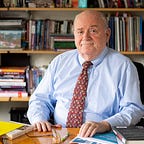Strivers Like NASA’s Katherine Johnson Deserve Equal Opportunities
By Anthony P. Carnevale
Katherine Johnson, who became a household name because of her portrayal in the movie Hidden Figures, was born in 1918 in a West Virginia town with segregated schools that didn’t have classes for Black children past the sixth grade. Every fall her parents, a farmer and a schoolteacher, moved the family to another town where she and her siblings could attend high school.
Eventually, she would earn not just a high school diploma but also a bachelor’s degree, and she would be one of three Black graduate students chosen to integrate West Virginia University. Today, Johnson is known for the mathematical calculations that she made by hand in her 33 years at NASA, which helped make possible the first American space flights in the early 1960s.
Strivers like Katherine Johnson are unique to American society, where we believe that everyone has an equal opportunity to succeed, even though outcomes may be unequal. In America, the combination of merit and opportunity is supposed to add up to success.
To ensure equal opportunity, despite vastly unequal economic outcomes, Americans turned to public education. In the last few decades, college has become the most well-traveled pathway to the middle class. As a result, the extent to which colleges admit and graduate racial and ethnic minority and low-income students affects these students’ economic mobility for the rest of their lives.
Katherine Johnson’s story reflects American values, but it’s not the reality for most Americans. Our research shows that higher education has become two separate and unequal tracks stratified by race and class. Today’s higher education system leads to unequal results for equally performing students, as qualified lower-SES students go to college and graduate at lower levels than their peers.
White students are overrepresented at selective public colleges, which are well-funded and have high graduation rates. By contrast, Black and Latino are represented at selective colleges at only half the rate they are represented in society overall. The majority of Black and Latino students are funneled into open-access public colleges that are underfunded and have low graduation rates. At the most selective colleges, only 3 percent of enrollment comes from the bottom SES quartile.
The reality is that opportunity isn’t equally distributed in American society — it’s an accident of birth. And there are hundreds of thousands of strivers, like Katherine Johnson as a girl in West Virginia, who don’t have the opportunities that they need to succeed.
Unfortunately, higher education is not yet the lever for economic mobility that we need it to be. It has the potential to provide all students with economic mobility, but to accomplish that, college admissions practices need to be structured to better identify and admit strivers. Selective public colleges in particular should rely less heavily on standardized test scores. In addition, more state and federal spending should be allocated to currently underfunded open-access public colleges. With the right policy changes, we could eventually start telling more stories like Katherine Johnson’s.
Dr. Carnevale is the director and research professor at the Georgetown University Center on Education and the Workforce. CEW is an independent, nonprofit research and policy institute affiliated with the Georgetown McCourt School of Public Policy that studies the link between education, career qualifications, and workforce demands.
Follow the Georgetown University Center on Education and the Workforce on Twitter (@GeorgetownCEW), LinkedIn, YouTube, and Facebook, and read more from CEW on economic and racial equity here.
